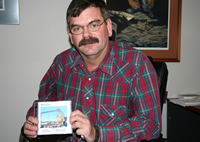 What if a mine could transport ore underground quickly and inexpensively and, at the same time, reduce diesel emissions?
What if a mine could transport ore underground quickly and inexpensively and, at the same time, reduce diesel emissions?
Starting in September 2008, Sudbury-based Rail-Veyor Technologies Inc. will demonstrate a novel conveyance system for Vale Inco on a piece of land it is leasing at the company’s Frood-Stobie Complex in Sudbury.
Vale Inco is considering implementing the conveyance system in at least two underground applications, said Fred Baker, project manager for Rail-Veyor.
“We think that once we’re able to show what happens with the demonstration plant, that it actually works, and we’re able to address some of the concerns they have, (the mining industry) will adopt the technology,” he said.
Rail-Veyor moves materials using a light rail track system with a series of two-wheeled, inter-connected cars that typify a long, open trough moving along the track.
Unlike traditional rail haulage systems which have to start and stop to load individual cars, Rail-Veyor can be loaded continuously.
Each car is connected to the car in front with a connection that allows articulated movement for curves and dumping.
Sealing of the gap between cars is maintained by the use of overlapping urethane flaps, which prevent leakage of the material and act as a discharge chute for dumping the load.
When the ore is dumped, the track turns upside down like a rollercoaster and the ore falls out in a controlled fashion. Return to the upright position is provided by a 180-degree twist.
“The system is designed so that it has no operator on the train. It’s all operated remotely with computers in a control room,” said Baker.
Unlike traditional, diesel-powered underground rail haulage trains requiring heavy locomotives, Rail-Veyor uses a series of equally-spaced stationary drive stations to move the cars.
Electric motors turn horizontal, foam-filled tires against the side drive plates of the cars, providing forward thrust.
Because the technology is powered by electricity, it doesn’t release harmful fumes into the mine, reducing the need for ventilation.
The electricity it does use is minimal because only the drive stations in contact with the cars are in motion.
While Rail-Veyor is only slightly less expensive to purchase than traditional rail haulage systems, it is much less costly to operate because it doesn’t have to stop and start to load, and one operator can take care of multiple trains.
Invented several years ago by a U.S. inventor, Mike Dibble, the conveyance system moves quickly - at 10 metres per second while transporting ore, three metres per second while dumping and one metre per second while loading.
The only commercial application of the Rail-Veyor system to date is at a Harmony Gold mine in South Africa. A second system was built for demonstration purposes in Florida.
Risto Laamanen, CEO of Laamanen Construction, acquired the North American rights to the Rail-Veyor Transportation System and established Rail-Veyor Technologies Inc. about a year ago.
For now, the technology’s loading and dumping system will not be part of the demonstration plant at the Frood-Stobie Complex, said Baker.
These components of the Rail-Veyor system have been successfully demonstrated in Florida and at the Harmony Gold mine in South Africa.
Instead, it will focus on the technology’s ability to work on a 20 per cent incline, something that is not possible using traditional rail haulage systems.
“It will demonstrate that the conveyance system will go up and down the ramp and will start and stop,” Baker said.
“Florida and South Africa also have extremely different weather than Sudbury. We want to see how it operates in the snow and freezing rain.”
The loading and dumping system will eventually be added to the Sudbury demonstration plant because it will be used in the future to convince other mining companies in North America to purchase the technology, said Baker.
“We hope to keep this on site and operating for a couple of years. We certainly will be marketing this in North America with the expectation that seriously interested clients will come here and have a look at it.”


